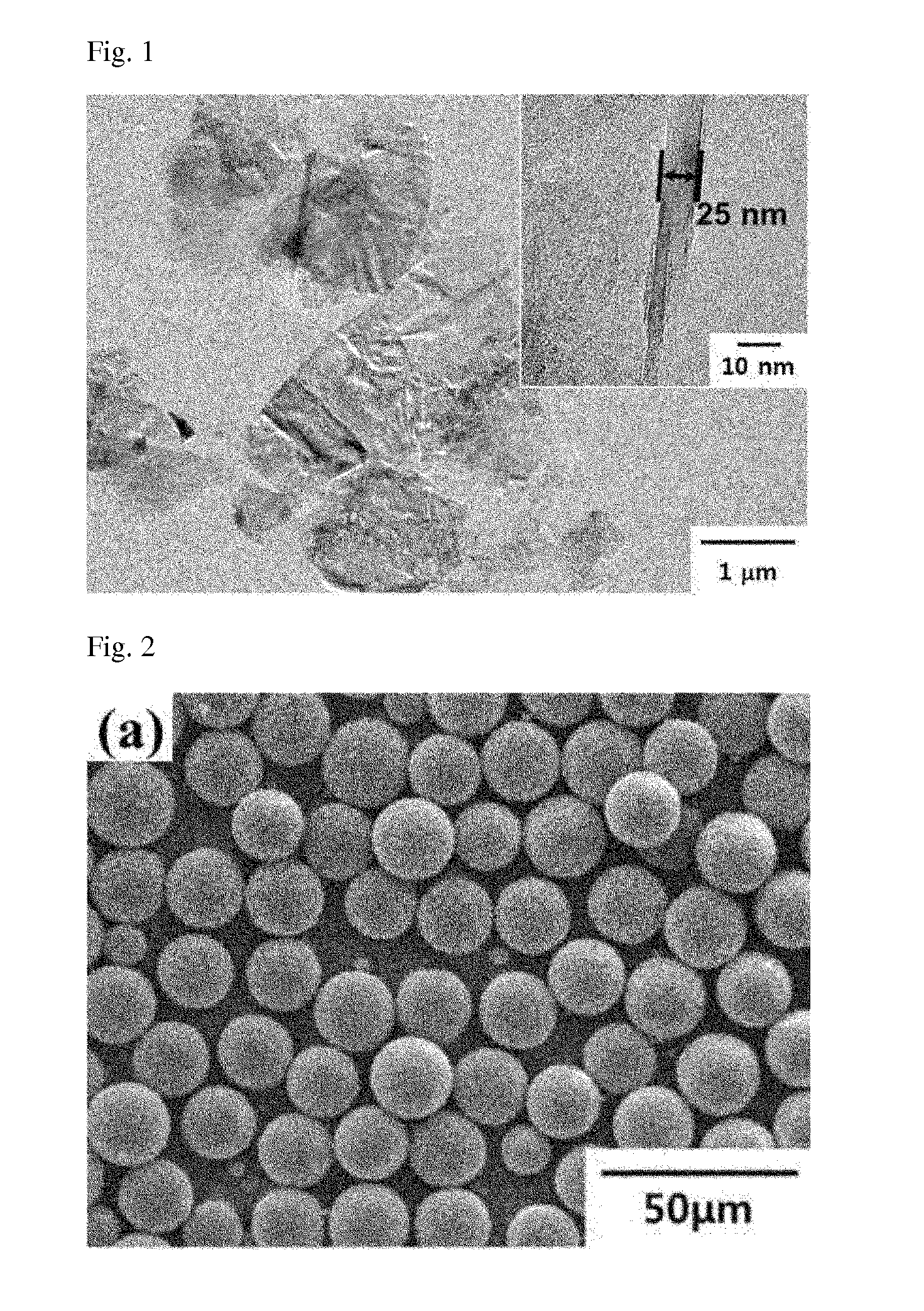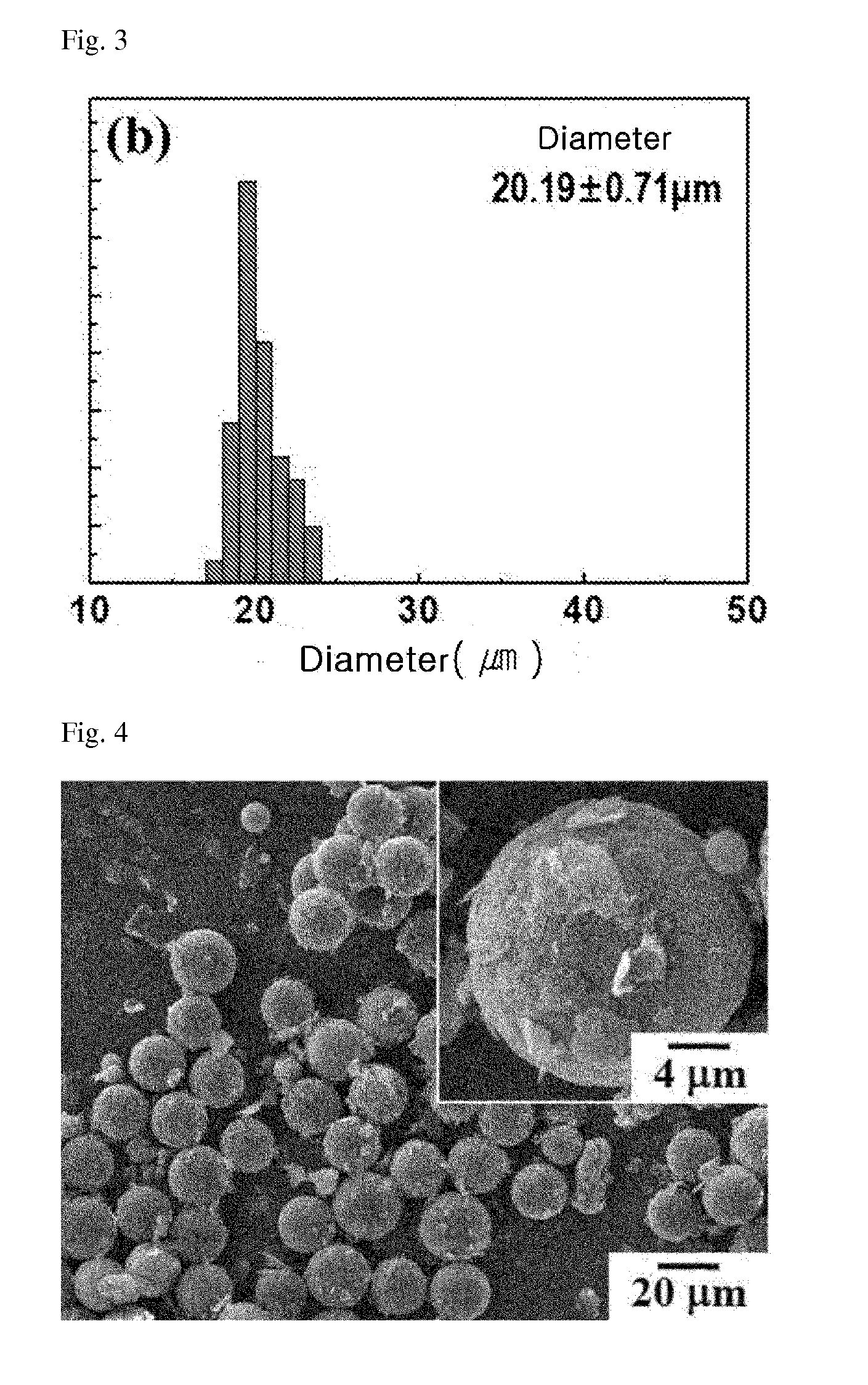Thermally Conductive Ceramic-Polymer Composite and Method of Preparing the Same
a ceramic polymer and composite technology, applied in the field of ceramic polymer composites, can solve the problems of increasing cost, sharp increase in viscosity, and heavy devices, and achieve the effects of increasing the life cycle of batteries, excellent electrical insulation, and excellent thermal conductivity
- Summary
- Abstract
- Description
- Claims
- Application Information
AI Technical Summary
Benefits of technology
Problems solved by technology
Method used
Image
Examples
example 1
[0072]Boron nitride fragments and γ-glycidoxypropyl-trimethoxysilane were added to isopropyl alcohol having pH 4, thereby performing a surface treatment on the boron nitride fragments. While stirring, the boron nitride fragments and the γ-glycidoxypropyl-trimethoxysilane were mixed at 80° C. for 2 hours, thereby preparing the boron nitride fragments surface-treated with the γ-glycidoxypropyl-trimethoxysilane. The γ-glycidoxypropyl-trimethoxysilane and the boron nitride fragments were added at a weight ratio of 0.5:99.5, 1:99, 3:97 or 5:95, and mixed. The stirring was performed at a rotational speed of approximately 50 rpm.
[0073]PMMA beads and the surface-treated boron nitride fragments were added to a solvent having insolubility with respect to the PMMA beads, and dispersed. For dispersion, the surface-treated boron nitride fragments and the PMMA beads were added to 500 ml of isopropyl alcohol at volumetric ratios of 1:9 and 2:8, respectively, and mixed by stirring for 10 hours. The...
experimental example 1
[0095]To examine the effect of the surface treatment of boron nitride with the γ-glycidoxypropyl-trimethoxysilane (GPS) on a heat dissipating property of the composite, heat dissipation properties of the boron nitride-PMMA composite prepared according to Example 1 and the boron nitride-PMMA composite prepared according to Comparative Example 1 were compared.
[0096]FIG. 8 is a graph of thermal conductivity of the boron nitride-PMMA composites prepared according to Example 1 and Comparative Example 1 according to the addition of the γ-glycidoxypropyl-trimethoxysilane (GPS), which is measured by a heat flow method, wherein the boron nitride fragments and the PMMA beads were added at a volumetric ratio of 1:9.
[0097]Referring to FIG. 8, in the boron nitride-PMMA composite prepared without using the γ-glycidoxypropyl-trimethoxysilane (GPS) (in FIG. 8, the boron nitride-PMMA composite prepared according to Comparative Example 1 in which a GPS content was 0), a thermal conductivity was measu...
experimental example 2
[0098]To examine the effect of the arrangement of ceramic fillers of the composite on the increase in thermal conductivity, heat dissipation properties of the composite having an aligned boron nitride (BN) arrangement prepared according to Example 1 (the boron nitride-PMMA composite prepared according to Example 1) and the composite in which boron nitride was simply dispersed (the boron nitride-PMMA composite prepared according to Comparative Example 2) were compared.
[0099]FIG. 9 is a graph of comparison of thermal conductivities measured according to the content of boron nitride in the boron nitride-PMMA composite through a heat flow method.
[0100]Referring to FIG. 9, an increase in thermal conductivity was observed according to the input of boron nitride under all conditions. Meanwhile, it was confirmed that, in the composition in which boron nitride was not regularly arranged but simply dispersed (represented as PMMA(R) in FIG. 9(a)), when an input of boron nitride was 10 vol % (w...
PUM
| Property | Measurement | Unit |
|---|---|---|
| Fraction | aaaaa | aaaaa |
| Pressure | aaaaa | aaaaa |
| Percent by mass | aaaaa | aaaaa |
Abstract
Description
Claims
Application Information
 Login to View More
Login to View More - R&D
- Intellectual Property
- Life Sciences
- Materials
- Tech Scout
- Unparalleled Data Quality
- Higher Quality Content
- 60% Fewer Hallucinations
Browse by: Latest US Patents, China's latest patents, Technical Efficacy Thesaurus, Application Domain, Technology Topic, Popular Technical Reports.
© 2025 PatSnap. All rights reserved.Legal|Privacy policy|Modern Slavery Act Transparency Statement|Sitemap|About US| Contact US: help@patsnap.com



